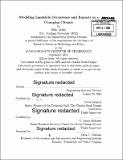Modeling landslide occurrence and impacts in a changing climate
Author(s)
Leidy, Erin, S.M. Massachusetts Institute of Technology
DownloadFull printable version (15.56Mb)
Other Contributors
Massachusetts Institute of Technology. Technology, Management, and Policy Program.
Advisor
Cathy Slesnick and C. Adam Schlosser.
Terms of use
Metadata
Show full item recordAbstract
In the coming years and decades, shifts in weather, population, land use, and other human factors are expected to have an impact on the occurrence and severity of landslides. A landslide inventory database from Switzerland is used to perform two types of analysis. The first presents a proof of concept for an analogue method of detecting the frequency in landslide activity with future climate change conditions. Instead of relying on modeled precipitation, it uses composites of atmospheric variables to identity the conditions that are associated with days on which a landslide occurred. The analogues are compared to relevant meteorological variables in MERRA reanalysis data to achieve a success rate of over 50% in matching observed landslide days within 7 days. The second analysis explores the effectiveness of machine learning as a technique to evaluate the likelihood of a slide to create high damage. The algorithm is tuned to accommodate unbalanced data, extraneous variables, and variance in voting to achieve the best predictive success. This method provides an efficient way of calculating vulnerability and identifying the spatial and temporal factors which influence it. The results are able to identify high damage landslides with a success of upwards of 70%. A machine-learning based model has the potential for use as a policy tool to identify areas of high risk.
Description
Thesis: S.M. in Technology and Policy, Massachusetts Institute of Technology, Engineering Systems Division, 2014. Cataloged from PDF version of thesis. Includes bibliographical references (pages 123-128).
Date issued
2014Department
Massachusetts Institute of Technology. Engineering Systems DivisionPublisher
Massachusetts Institute of Technology
Keywords
Engineering Systems Division., Technology, Management, and Policy Program.